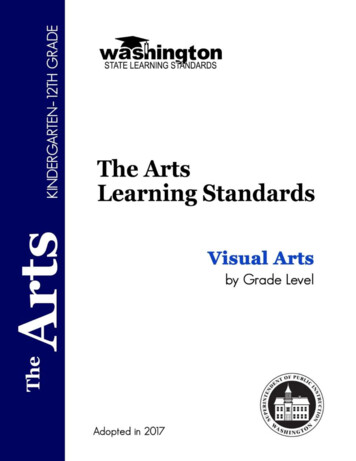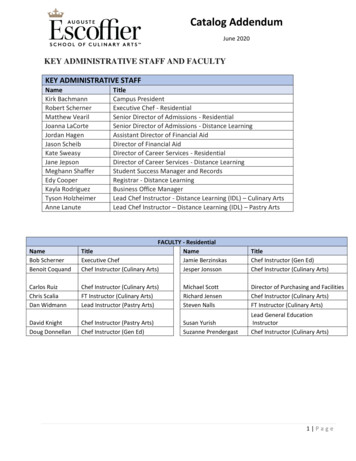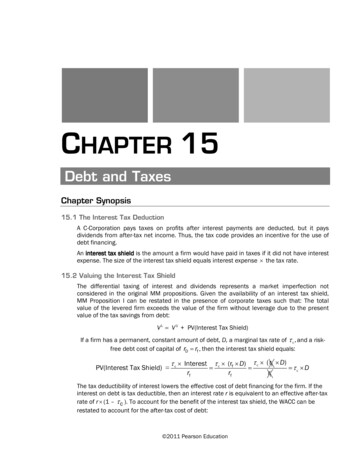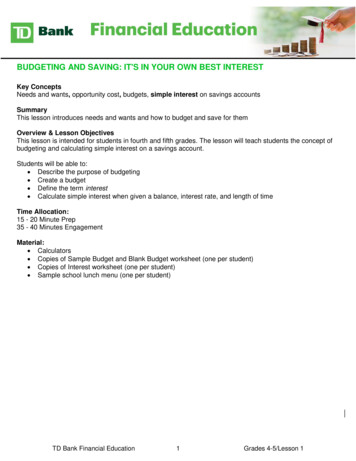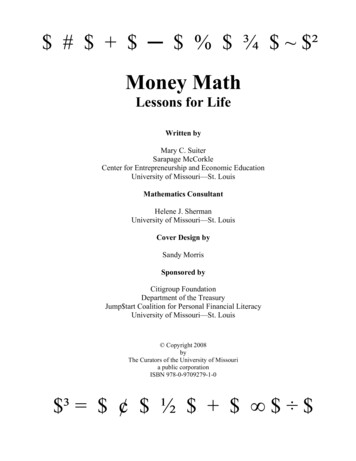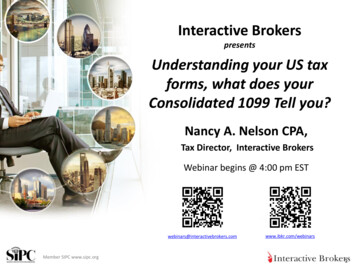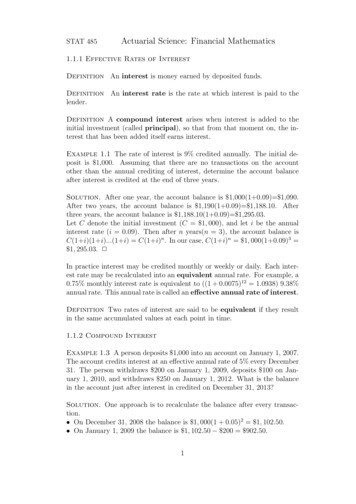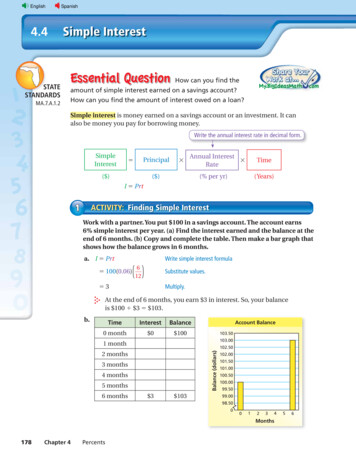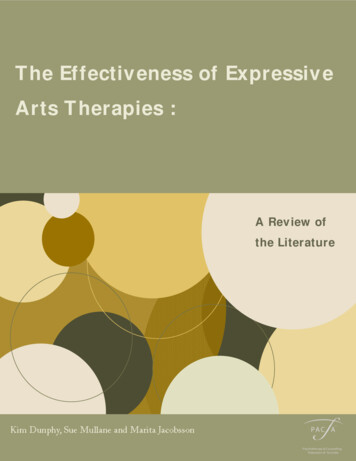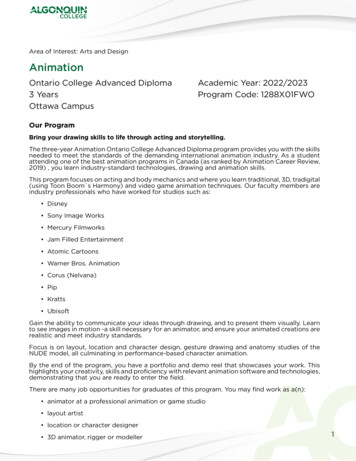
Transcription
Area of Interest: Arts and DesignAnimationOntario College Advanced Diploma3 YearsOttawa CampusAcademic Year: 2022/2023Program Code: 1288X01FWOOur ProgramBring your drawing skills to life through acting and storytelling.The three-year Animation Ontario College Advanced Diploma program provides you with the skillsneeded to meet the standards of the demanding international animation industry. As a studentattending one of the best animation programs in Canada (as ranked by Animation Career Review,2019) , you learn industry-standard technologies, drawing and animation skills.This program focuses on acting and body mechanics and where you learn traditional, 3D, tradigital(using Toon Boom s Harmony) and video game animation techniques. Our faculty members areindustry professionals who have worked for studios such as: Disney Sony Image Works Mercury Filmworks Jam Filled Entertainment Atomic Cartoons Warner Bros. Animation Corus (Nelvana) Pip Kratts UbisoftGain the ability to communicate your ideas through drawing, and to present them visually. Learnto see images in motion -a skill necessary for an animator, and ensure your animated creations arerealistic and meet industry standards.Focus is on layout, location and character design, gesture drawing and anatomy studies of theNUDE model, all culminating in performance-based character animation.By the end of the program, you have a portfolio and demo reel that showcases your work. Thishighlights your creativity, skills and proficiency with relevant animation software and technologies,demonstrating that you are ready to enter the field.There are many job opportunities for graduates of this program. You may find work as a(n): animator at a professional animation or game studio layout artist location or character designer 3D animator, rigger or modeller1
Animation background artist tradigital riggerOther employment opportunities might include working on feature films, animated TV series orcommercials.SUCCESS FACTORSThis program is well-suited for students who: Are creative and think visually. Enjoy a hands-on approach to learning about the animation and game industries. Have strong observational and analytical skills. Have an aptitude for acting and storytelling. Are eager to learn new drawing and animation techniques using new technologies.EmploymentGraduates may find employment in the booming animation industry in local (Ottawa) studios, orCanadian animation centres like Toronto, Halifax, Montreal, Vancouver or with studios around theworld. Animation grads are sought after, with a hiring rate in the 90% range with 100% employersatisfaction according to post graduate surveys. Third year students might also have theopportunity to work in a studio during part of the school year. There are also opportunities foradvanced learning to earn a degree through our articulation partners.Learning OutcomesThe graduate has reliably demonstrated the ability to: Design, create and animate objects and characters with naturalistic and expressivemovements and poses. Design and create hand-drawn and/or computer-generated drawings using principles of art,design and composition. Select and use appropriate tools and technologies for the development of animation projects. Contribute to the planning, implementation and evaluation of animation projects. Plan, develop and execute a series of effective and believable animation sequences. Create and enhance the production of animation sequences and projects using a variety ofprinciples and techniques related to cinematography and art direction. Use storytelling skills to create and enhance the development and execution of animationsequences. Use performance theory and skills to create and enhance animation. Design and produce layouts using perspective, composition and colour theory to enhancevisual presentation and mood. Present and defend a visual concept to a target audience. Use computer skills and appropriate digital asset management techniques to functioneffectively within a production pipeline. Develop, assemble and present a demo reel or portfolio in a manner that meets currentindustry expectations, and highlights one s creativity, skills and proficiency with relevantanimation software and related technologies.2
Animation Identify and apply discipline-specific practices that contribute to the local and globalcommunity through social responsibility, economic commitment and environmentalstewardship.Program of StudyLevel: 01CoursesANI1513Life Drawing for Animation IANI1550Animation Design IANI1557Animation Practices and Principles IANI1559Environmental and Visual Problem Solving IANI1592Animation Drawing IENL1813MCommunications ILevel: 02CoursesANI1523Life Drawing for Animation IIANI1551Animation Design IIANI1558Animation Practices and Principles IIANI1593Animation Drawing IIANI1618Character Design IDSN2100MDesign ThinkingENL1839Scriptwriting for AnimationLevel: 03CoursesANI1552Life Drawing for Animation IIIANI1553Animation Design IIIANI1567Character Animation IANI16343D Animation ILevel: 04CoursesANI1555Animation Design IVANI1590Character Animation IIANI1607Life Drawing for Animation IVANI16353D Animation IIChoose one from equivalencies:CoursesGED1288General Education ElectiveLevel: 05CoursesANI1578Life Drawing VANI16262D Digital Animation IANI1627Independent Study IANI1628Masterclass IANI1629Gesture Drawing for Animation ILevel: 06CoursesANI1584Life Drawing VIANI1586Business Studies for AnimationANI16302D Digital IIANI1631Independent Study IIANI1632Masterclass IIANI1633Gesture Drawing for Animation IIFees for the 2022/2023 Academic rs56.042.056.0112.056.028.03
AnimationTuition and related ancillary fees for this program can be viewed by using the Tuition and FeesEstimator tool at https://www.algonquincollege.com/fee-estimator .Further information on fees can be found by visiting the Registrar s Office website athttps://www.algonquincollege.com/ro .Fees are subject to change.Additional program-related expenses include:Books and supplies cost approximately 1,700 in the first year and 2,000 in the second and thirdyear.We recommend that the first year students purchase one portable external hard drive with acapacity of at least 1 terabyte TB.Before beginning the program, students are required to purchase either a MacOS or Windowslaptop with these minimum specs (cost: 1,700- 3,000): Intel Core i7 processor 16GB RAM 500GB SSD internal storage 15 or larger screen Dedicated (Discrete) video card with 4GB RAMAutodesk Maya 2020 technical specs. quirements-for-Autodesk-Maya.htmlToon Boom Harmony 17 Premier technical specs. equirementsAccessories:Purchase a three-button mouse of your choice. Purchase a mouse pad of your choice. It isrecommended that students buy the three-year Apple Care warranty, if purchasing the Mac.Students may wish to purchase a portable drafting table, chair and shelving system. Third yearstudents are required to purchase a Cintiq pen.Admission Requirements for the 2023/2024 Academic YearCollege Eligibility Ontario Secondary School Diploma (OSSD) or equivalent. Applicants with an OSSD showingsenior English and/or Mathematics courses at the Basic Level, or with Workplace or Opencourses, will be tested to determine their eligibility for admission; OR Academic and Career Entrance (ACE) certificate; OR General Educational Development (GED) certificate; OR Mature Student status (19 years of age or older and without a high school diploma at thestart of the program). Eligibility may be determined by academic achievement testing forwhich a fee of 50 (subject to change) will be charged.Program Eligibility English, Grade 12 (ENG4C or equivalent). Submit a portfolio of 10-15 samples illustrating artistic ability. The portfolio must includesamples of formal life drawing, perspective drawing, and fantasy or cartoon drawing. Detailsof an additional home drawing test will be sent upon receipt of your application. Samples ofwork to be submitted for assessment must be 8-1/2 x 11. Portfolio submission details can befound on the Algonquin College Additional Admission Requirements spackages .4
Animation NOTE: Interested applicants are welcome to address any portfolio-related inquiries to:mailto:design@algonquincollege.com . Applicants with international transcripts must provide proof of the subject-specificrequirements noted above and may be required to provide proof of language proficiency.Domestic applicants with international transcripts must be evaluated through the InternationalCredential Assessment Service of Canada (ICAS) or World Education Services (WES). IELTS-International English Language Testing Service (Academic) Overall band of 6.0 witha minimum of 5.5 in each band; OR TOEFL-Internet-based (iBT) Overall 80, with a minimumof 20 in each component: Reading 20; Listening 20; Speaking 20; Writing 20.Not sure if you meet all of the requirements? Academic Upgrading may be able to help with that:https://www.algonquincollege.com/access/ .Should the number of qualified applicants exceed the number of available places, applicants willbe selected on the basis of their score on their portfolio.Admission Requirements for 2022/2023 Academic YearCollege Eligibility Ontario Secondary School Diploma (OSSD) or equivalent. Applicants with an OSSD showingsenior English and/or Mathematics courses at the Basic Level, or with Workplace or Opencourses, will be tested to determine their eligibility for admission; OR Academic and Career Entrance (ACE) certificate; OR General Educational Development (GED) certificate; OR Mature Student status (19 years of age or older and without a high school diploma at thestart of the program). Eligibility may be determined by academic achievement testing forwhich a fee of 50 (subject to change) will be charged.Program Eligibility English, Grade 12 (ENG4C or equivalent). Submit a portfolio of 10-15 samples illustrating artistic ability. The portfolio must includesamples of formal life drawing, perspective drawing, and fantasy or cartoon drawing. Detailsof an additional home drawing test will be sent upon receipt of your application. Samples ofwork to be submitted for assessment must be 8-1/2 x 11. Portfolio submission details can befound on the Algonquin College Additional Admission Requirements website: www.algonquincollege.com/admissionspackages. NOTE: Interested applicants are welcome toaddress any portfolio-related inquiries to: design@algonquincollege.com. Applicants with international transcripts must provide proof of the subject-specificrequirements noted above and may be required to provide proof of language proficiency.Domestic applicants with international transcripts must be evaluated through the InternationalCredential Assessment Service of Canada (ICAS) or World Education Services (WES). IELTS-International English Language Testing Service (Academic) Overall band of 6.0 witha minimum of 5.5 in each band;OR TOEFL-Internet-based (iBT) Overall 80, with a minimumof 20 in each component: Reading 20; Listening 20; Speaking 20; Writing 20.Should the number of qualified applicants exceed the number of available places, applicants willbe selected on the basis of their proficiency in English.Application InformationANIMATIONProgram Code 1288X01FWOApplications to full-time day programs must be submitted with official transcripts showingcompletion of the academic admission requirements through:ontariocolleges.ca5
Animation60 Corporate CourtGuelph, Ontario N1G 5J31-888-892-2228Students currently enrolled in an Ontario secondary school should notify their Guidance Officeprior to their online application at http://www.ontariocolleges.ca/ .Applications for Fall Term and Winter Term admission received by February 1 will be given equalconsideration. Applications received after February 1 will be processed on a first-come, first-servedbasis as long as places are available.International applicants please visit thishttps://algonquincollege.force.com/myACint/ .linkforapplicationprocessinformation:For further information on the admissions process, contact:Registrar s OfficeAlgonquin College1385 Woodroffe AveOttawa, ON K2G 1V8Telephone: 613-727-0002Toll-free: 1-800-565-4723TTY: 613-727-7766Fax: 613-727-7632Contact: https://www.algonquincollege.com/roAdditional InformationPlease note: All life drawing courses involve nudity.For more information, please contact the following Program Coordinators: Paul West at613-727-4723 ext. 5504 or mailto:westp@algonquincollege.com , Neil Hunter at 613-727-4723 ext.5821 or mailto:huntern@algonquincollege.com , Tom Crook at 613-727-4723 ext. 5816 ormailto:crookt@algonquincollege.com .Course DescriptionsANI1513 Life Drawing for Animation ILife drawing is a fundamental skill for creating believability in our animated drawings of motion.Through the use of casts and models, the student is introduced to the sight measurement techniqueand gesture drawing. Emphasis is on maintaining proportions, foreshortening and the developmentof good drawing skills that can be applied to the animation process. Warning: Nude models areused in all of our life drawing classes.Prerequisite(s): noneCorerequisite(s):noneANI1523 Life Drawing for Animation IIAnimated sequences are created by caricaturing the movements of real human bodies. Studentshone their sight measurement and gesture drawing skills. Landmarks of the human form areexplored through the study of human anatomy. The identification and comprehension of the body'smuscles and bones allows students to create drawings that show a sense of accuracy and solidityof form. Warning: Nude models are used in all of our life drawing classes.Prerequisite(s): ANI1513 and ANI1550 and ANI1557 and ANI1592Corerequisite(s):noneANI1550 Animation Design IAnimation design deals with the staging or environment that the animated character interactswith, whether it be a living room or forest location. The use of perspective plays a major role inthe creation of these location designs. Students are introduced to layout and design for animatedproductions. Students learn the basics and history of perspective and structured drawings. Othertopics include how to get research material and shot composition.6
AnimationPrerequisite(s): noneCorerequisite(s):noneANI1551 Animation Design IIA good layout artist is able to evoke an emotional response from their audience. Students createmore advanced layouts that include a firmer grasp of perspective drawing. Topics such as ellipsesand exterior layouts are studied. Students work on storytelling by creating an exterior forest layoutand an interior front hall with a stair case, which focuses on inclined planes.Prerequisite(s): ANI1513 and ANI1550 and ANI1557 and ANI1592Corerequisite(s):noneANI1552 Life Drawing for Animation IIIIllustration of three-dimensional drawing involves the utilization of shading. By using simple lightingtechniques, students add light and shadow to the surface planes of the body. Gesture drawing isfurther developed, along with an exploration of muscles in motion through a series of movementexercises. Warning: Nude models are used in all of our life drawing classes.Prerequisite(s): ANI1523 and ANI1551 and ANI1558 and ANI1593Corerequisite(s):noneANI1553 Animation Design IIIThe ability to draw an environment from any angle is a skill needed by any good layout artist.Students use three-point perspective and employ a variety of camera angles in their layouts.Storytelling in design takes the forefront as students work on a room with personality assignment.Prerequisite(s): ANI1523 and ANI1551 and ANI1558 and ANI1593Corerequisite(s):noneANI1555 Animation Design IVFor the purposes of performance, animators need guides to create consistency of characters indifferent views, along with a range of emotions. These guides are called "model packs." Studentscan choose to work on character design or layouts. Students focus on character design modelsheets (rotations/turnarounds) and explore location designs. Layout students work on panbackgrounds.Prerequisite(s): ANI1552 and ANI1553 and ANI1567Corerequisite(s):noneANI1557 Animation Practices and Principles IThe animation industry now relies on multiple tools in the production process. Students learn theprinciples of animation and how to apply them to classical, 3D and 2D tradigital animationassignments. Students explore the interfaces, controls and general techniques of multiple softwareprograms in the creation of animated projects.Prerequisite(s): noneCorerequisite(s):noneANI1558 Animation Practices and Principles IIStudents investigate character movement by applying the basic principles of animation to morecomplex animated movements such as shifting weight and walks. Topics include squash andstretch, anticipation, follow-through and overlapping action, and appealing motion. Students studyall aspects of animation using traditional and 2D tradigital tools.Prerequisite(s): ANI1513 and ANI1550 and ANI1557 and ANI15927
AnimationCorerequisite(s):noneANI1559 Environmental and Visual Problem Solving IThe ergonomics of design and the understanding of aesthetics through real world observationare essential skills for the animator. Students explore the foundations of design through the creativeprocess. Using individual and group studies, students solve problems using creativity, imaginationand the ability to visually communicate their ideas.Prerequisite(s): noneCorerequisite(s):noneANI1567 Character Animation IPantomime acting is an integral part of animation. It allows the audience to "instantly read/know"what motivates a character's actions. Students make a character appear to think and makedecisions based on external forces or internal motivations. Important animation building blocks,such as timing, moving holds, posing, staging, beats/phrasing, appeal, personality, solid drawing,simplification of form and the use of straights against curves are explored. Active participation inthe Ottawa International Animation Festival is recommended to all students.Prerequisite(s): ANI1523 and ANI1551 and ANI1558 and ANI1593Corerequisite(s):noneANI1578 Life Drawing VDrawing figures is enhanced by the practice of observational skills. Topics include tonal drawings,such as how to draw drapery, muscular and skeletal studies of animals and humans, expressivegesture drawing and creating animated drawings through pose association exercises. Mixed media,such as conte and pastels are introduced. Warning: Nude models are used in all of our life drawingclasses.Prerequisite(s): ANI1555 and ANI1590 and ANI1607 and ANI1635Corerequisite(s):noneANI1584 Life Drawing VIStudents hone their life drawing skills through a continued study of expressive gesture and longpose drawing. Emphasis is on professional quality rendering through exercises that focus onrhythm, dynamic drawing and exaggeration. Warning: Nude models are used in all of our lifedrawing classes.Prerequisite(s): ANI1578Corerequisite(s):noneANI1586 Business Studies for AnimationStudents gain insight into business practices and the principles of operating a small business. Thecourse culminates with the development of an Electronic Press Kit for their short films. The courseremains current through the exploration of emerging trends and issues that impact the industry.Guest speakers from a variety of representative businesses are invited to share their experiencesand insights with students.Prerequisite(s): ANI1578 and ANI1626 and ANI1627 and ANI1628 and ANI1629Corerequisite(s):noneANI1590 Character Animation IIHow an animated character delivers a line of dialogue is as important as why. The emphasis is onsound, lip sync and dialogue acting involving body and facial expressions. Through a series ofexercises that begin with character animation syncing up with sound, students learn body andfacial acting and how to make a character talk. Focus is on strong story-telling poses, accurate8
Animationmouth shapes and proper facial expressions.Prerequisite(s): ANI1552 and ANI1553 and ANI1567Corerequisite(s):noneANI1592 Animation Drawing IAnimation drawing is the backbone of the industry. Using mostly traditional drawing techniques,complemented by 2D tradigital, students apply the basic principles of animation and drawingthrough simple, object-oriented assignments. Focus is on the fundamentals of timing, spacing andthe cartoon' physics of motion.Prerequisite(s): noneCorerequisite(s):noneANI1593 Animation Drawing IIStudents learn to develop the principles of animation to a higher level. Studies include animationof more complex actions. Body mechanics and action analysis are emphasized to raise students'observation skills and understanding of complex movement. Traditional and 2D tradigital tools areutilized.Prerequisite(s): ANI1513 and ANI1550 and ANI1557 and ANI1592Corerequisite(s):noneANI1607 Life Drawing for Animation IVWhen animating a scene, animators start planning their action by creating thumbnail drawings.These drawings are quick gesture sketches of the motion they are going to animate. Studentscreate thumbnail drawings of the human form in motion through the use of "flipping" technique.The study of anatomy and gesture techniques are continued and refined. Focus is also on moreadvanced shading skills. Warning: Nude models are used in all of our life drawing classes.Prerequisite(s): ANI1552Corerequisite(s):noneANI1618 Character Design IDesigning characters with appeal, originality and emotion is a critical skill of a good characterdesigner. By exploring different character designs and styles, students gain insight into theconstruction and structure of character design. Silhouetting, posing, acting, as well as creatingcharacter rotations elevate students' drawing skills.Prerequisite(s): ANI1550 and ANI1592Corerequisite(s):noneANI1626 2D Digital Animation IFocus is on creating animation utilizing industry standard animation software, such as Toon BoomHarmony. Becoming familiar with posing and animating pre-made rigged characters assist inpreparing students for the type of situations they encounter in a studio environment.Prerequisite(s): ANI1555 and ANI1590 and ANI1607 and ANI1635Corerequisite(s):noneANI1627 Independent Study IThis modular-based course allows students to focus their efforts on a particular animationdiscipline. Students form a plan with their instructors to develop their skills in animation, rigging,layout, storyboarding, special effects or other areas so they can concentrate on developing aportfolio specific to the job they wish to pursue in a studio.9
AnimationPrerequisite(s): ANI1555 and ANI1590 and ANI1607 and ANI1635Corerequisite(s):noneANI1628 Masterclass IStudents are exposed to many aspects of animation through lectures, step-by-step instructionand guest speakers from the animation community. Topics covered include colour theory, advancedtiming techniques, storyboarding, rigging, composition, character design, modeling and a widerange of other topics.Prerequisite(s): ANI1555 and ANI1590 and ANI1607 and ANI1635Corerequisite(s):noneANI1629 Gesture Drawing for Animation IGesture drawing is the backbone of the kind of expressive solid drawing that animation requires.Focus is on developing quick dynamic sketching of the human form by analyzing the model andrecreating poses with fluid lines. "Pushing the pose" through use of exaggeration and expressingan emotional state are also explored. Warning: Nude models are used in all of our life drawingclasses.Prerequisite(s): ANI1555 and ANI1590 and ANI1607 and ANI1635Corerequisite(s):noneANI1630 2D Digital IIContinuing on what the students learned in 2D Digital 1, students continue to explore 2D digitalsoftware with more advanced techniques including augmenting pre-made rigs.Prerequisite(s): ANI1578 and ANI1626 and ANI1627 and ANI1628 and ANI1629Corerequisite(s):noneANI1631 Independent Study IIStudents continue to develop their skills through learning modules in animation, rigging, layout,storyboarding, special effects or other areas so they can concentrate on developing a portfoliospecific to the job they wish to pursue in a studio.Prerequisite(s): ANI1578 and ANI1626 and ANI1627 and ANI1628 and ANI1629Corerequisite(s):noneANI1632 Masterclass IIStudents learn many aspects of animation through lectures, step-by-step lessons and guestspeakers from animation professionals. Topics covered could include advanced perspectivetechniques, 3D polish, lighting, acting for animation and a wide range of other topics.Prerequisite(s): ANI1578 and ANI1626 and ANI1627 and ANI1628 and ANI1629Corerequisite(s):noneANI1633 Gesture Drawing for Animation IIStudents continue to learn to develop quick dynamic sketching of the human form to expressaction and emotion. Warning: Nude models are used in all of our life drawing classes.Prerequisite(s): ANI1578 and ANI1626 and ANI1627 and ANI1628 and ANI1629Corerequisite(s):noneANI1634 3D Animation IThe computer has become the standard viable tool in the creation of animated features. Using10
Animationthe Maya interface, students apply the fundamentals of animation through simple exercises thatinclude the bouncing ball, a blade of grass and a pendulum. Focus is on the application of theprinciples of animation, such as squash and stretch, timing and motion, anticipation, acting,reacting, follow-through and overlapping action, slow in and slow out, exaggeration, secondaryaction and appeal. Students recognize the art of lighting, rendering and modelling as a keycomponent of animation, by discussing three-point lighting, basic modelling and the applicationof rendering techniques.Prerequisite(s): ANI1523 and ANI1551 and ANI1558 and ANI1593Corerequisite(s):noneANI1635 3D Animation IIStudents begin to explore character locomotion. Exercises include walks, runs, acting and reacting.Focus is on the understanding of balance and weight of a character, beats/phrasing, as well ashow and why a character anticipates a move. Students understand the clarity of design, shapevariation and the value of structured characters in design. Focus is on strong shape associationrelative to character personality and basic rigging techniques, including placement of skeleton,joint hierarchy, forward and inverse kinematics and constraints.Prerequisite(s): ANI1634Corerequisite(s):noneDSN2100M Design ThinkingHuman-centred approaches are among the best methods of generating innovative solutions forpeople at work, at home or within your community. Design thinking is a user-centred method ofcreative problem solving applicable any time you need to generate new ideas. It is about embracingmindset shifts and tackling problems from the user's perspective. Students learn the five-stepprocess while involving the user each step of the way. Through research discussions and analysis,students work, first independently, then with a team, to emphasize with their users, define aproblem, and then ideate, prototype and test an original solution that places people at the heartof a challenge.Prerequisite(s): noneCorerequisite(s):noneENL1813M Communications ICommunication remains an essential skill sought by employers, regardless of discipline or field ofstudy. Using a practical, vocation-oriented approach, students focus on meeting the requirementsof effective communication. Through a combination of lectures, exercises, and independentlearning, students practise writing, speaking, reading, listening, locating and documentinginformation, and using technology to communicate professionally. Students develop andstrengthen communication skills that contribute to success in both educational and workplaceenvironments.Prerequisite(s): noneCorerequisite(s):noneENL1839 Scriptwriting for AnimationStudents are introduced to the basic concepts of screen writing. Students analyze animated andlive-action stories to determine the characteristics of effective screenplays. Students also writetheir own eleven-minute screenplay featuring original, animated characters.Prerequisite(s): ENL1813A or ENL1813M or ENL1813E or ENL1813K or ENL1813RCorerequisite(s):noneGED1288 General Education ElectiveStudents choose one course, from a group of general education electives, which meets one of thefollowing five theme requirements: Arts in Society, Civic Life, Social and Cultural Understanding,11
AnimationPersonal Understanding, and Science and Technology.Prerequisite(s): noneCorerequisite(s):none12
attending one of the best animation programs in Canada (as ranked by Animation Career Review, 2019) , you learn industry-standard technologies, drawing and animation skills. This program focuses on acting and body mechanics and where you learn traditional, 3D, tradigital (using Toon Boom s Harmony) and video game animation techniques.

